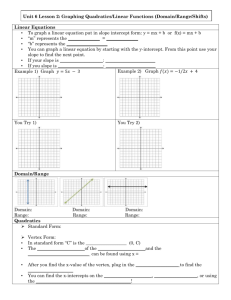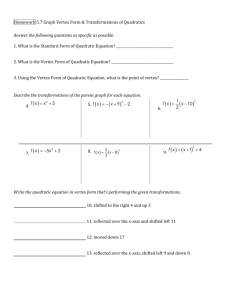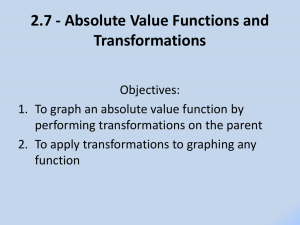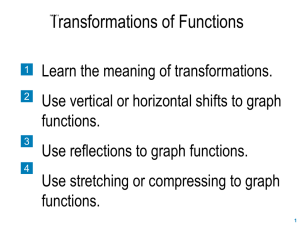Absolute Value and Transformations
advertisement
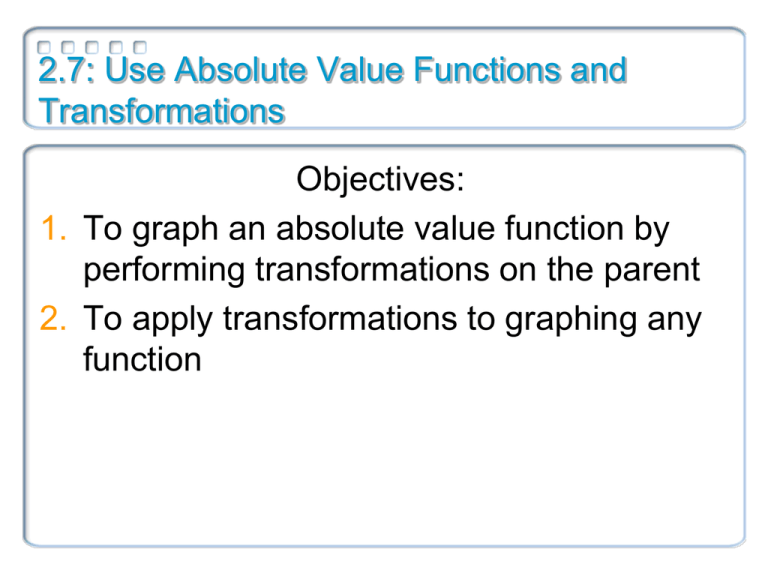
2.7: Use Absolute Value Functions and Transformations Objectives: 1. To graph an absolute value function by performing transformations on the parent 2. To apply transformations to graphing any function Building the Absolute Value Function The absolute value function is defined by f (x) = |x|. The graph of the absolute value function is similar to the linear parent function, except it must always be positive. 4 2 -5 5 -2 -4 Building the Absolute Value Function The absolute value function is defined by f (x) = |x|. So we just take the negative portion of the graph and reflect it across the x-axis making that part positive. 4 2 -5 5 -2 -4 Building the Absolute Value Function The absolute value function is defined by f (x) = |x|. This is the absolute value parent function. 4 2 -5 5 fx = x -2 -4 Parent Function • V-shape • It is symmetric about the y-axis • The vertex is the minimum point on the graph Translation A translation is a transformation that shifts a graph horizontally or vertically, but doesn’t change the overall shape or orientation. Translation The graph of y = |x – h| + k is the graph of y = |x| translated h horizontal units and y vertical units. • The new vertex is at (h, k) Stretching and Shrinking The graph of y = a|x| is graph of y = |x| vertically stretched or shrunk depending on the |a|. The value of a acts like the slope. Reflection The graph of y = a|x| is graph of y = |x| reflected across the x-axis when a < 0. 4 fx = - x 2 2 -5 4 5 -5 5 fx = x -2 -2 -4 -4 Multiple Transformations In general, the graph of an absolute value function of the form y = a|x – h| + k can involve translations, reflections, stretches or shrinks. To graph an absolute value function, start by identifying the vertex. Graphing Absolute Value Functions Graphing y = a|x – h| + k is easy: 1.Plot the vertex (h, k). (note…if +h inside that means h is negtive, if – h inside that means h is positive) 2.Use the a value as slope to plot more points. Remember you have to do positive and negative slope to get points on both sides of the V 3.Connect the dots in a V-shape. Exercise 2 Graph the following functions without making a table. 1. y = |x – 2| + 3 This graph will go right 2 and up 3 so from the origin go right 2 and up 3. This is the vertex (2, 3). Now from that point use the positive and negative slope (a = 1 here) to get more points. 4 2 -5 5 fx = x -2 -4 Exercise 2 Graph the following functions without making a table. 1.y = (1/2)|x| This function does not have an “h” or “k” so the vertex is (0, 0). Since a = ½ the slope is ½. Go up 1 and right 2 then up one and left 2. 4 2 -5 5 fx = x -2 -4 Exercise 2 Graph the following functions without making a table. 1.f (x) = -3|x + 1| – 2 This graph will go left 1 and down two so the vertex will be (-1, -2). Since “a” is negative the graph will open down. Since the value of “a” is 3 the slope will be 3 and -3 (just remember to go down.) 4 2 -5 5 fx = x -2 -4 Transformations in General You can perform transformations on the graph of any function in manner similar to transformations on the absolute value function.
